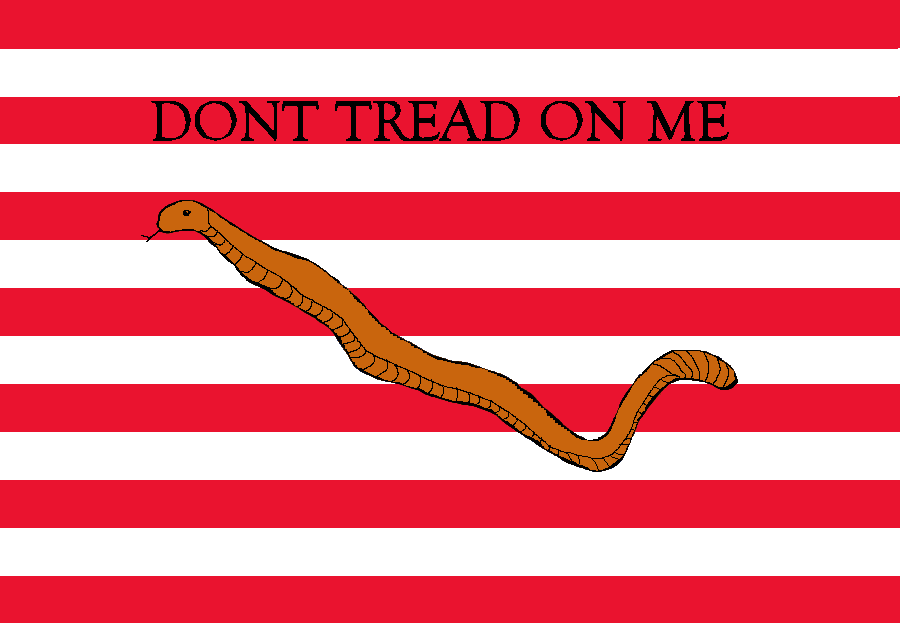


 The Ensign Of The South Carolina Navy is cometimes called the First Navy Jack. This flag, although existing mostly in legend, has been designated by the United States Navy as the first flag of the Continental Navy.
The Ensign Of The South Carolina Navy is cometimes called the First Navy Jack. This flag, although existing mostly in legend, has been designated by the United States Navy as the first flag of the Continental Navy.
 This flag's origin is unknown, and no sources mention the use of it during the American Revolutionary War. It appeared in the background of a portrait of Commodore Esek Hopkins, which was painted by the British artist, Thomas Hart. In that portrait, though, the flag appears to have seven white stripes and six red stripes, as compared to the version accepted by the U.S. Navy, and popular today. It has been suggested that the actual flag (if it did, indeed, exist) would prabably have had a field of seven red stripes and six white because outer white stripes would have blended into the horizon, making it more difficult to identify.
This flag's origin is unknown, and no sources mention the use of it during the American Revolutionary War. It appeared in the background of a portrait of Commodore Esek Hopkins, which was painted by the British artist, Thomas Hart. In that portrait, though, the flag appears to have seven white stripes and six red stripes, as compared to the version accepted by the U.S. Navy, and popular today. It has been suggested that the actual flag (if it did, indeed, exist) would prabably have had a field of seven red stripes and six white because outer white stripes would have blended into the horizon, making it more difficult to identify.
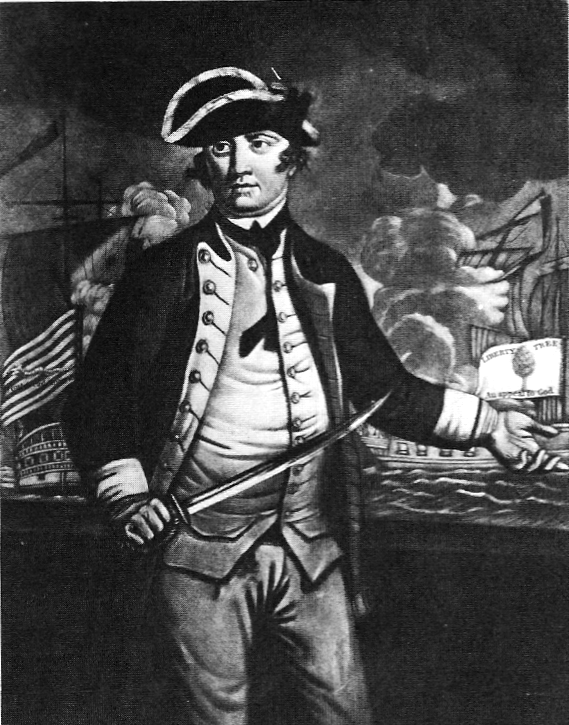
Commodore Hopkins, Commander in Chief of the American Fleet.
Published as the Act directs 22 Augt 1776 by Thos. Hart
Mezzotint engraved by C. Corbutt
This image maintained by the Library Of Congress
 Some people have made the assumption that the outstretched rattlesnake was intended as a visual joke on the Americans by the painter, Thomas Hart. They contend that the outstretched snake is fleeing. There is no reason to make that assumption any more than to assume that the snake is in the action of striking.
Some people have made the assumption that the outstretched rattlesnake was intended as a visual joke on the Americans by the painter, Thomas Hart. They contend that the outstretched snake is fleeing. There is no reason to make that assumption any more than to assume that the snake is in the action of striking.
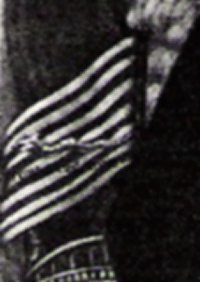
Detail.
 In March 1783, a cartoon was published in London which, among other things, shows a Rebel Stripes flag with a rattlesnake outstretched over the field. A portion of the text in the speech-bubble states: There you see the thirteen Stripes and Rattlesnake exalted...
In March 1783, a cartoon was published in London which, among other things, shows a Rebel Stripes flag with a rattlesnake outstretched over the field. A portion of the text in the speech-bubble states: There you see the thirteen Stripes and Rattlesnake exalted...
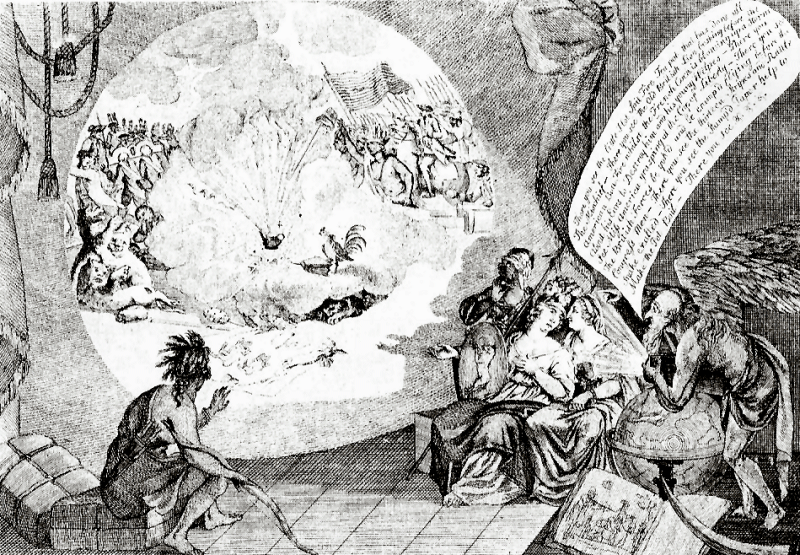
The Tea-Tax-Tempest, Or Old Time With His Magick-Lantern
Pubd. March 12, 1783. by W. Humphreys. N 227 Strand
Mixed media.
This image maintained by the Library Of Congress
 The actual use of this "rattlesnake flag" for the ship's jack has been questioned. Ignoring the image that appeared in the portrait of Commodore Hopkins, it should be noted that the jack often was associated with the ensign in design. In British ships, the jack was identical to the canton of the national ensign. Peter Ansoff, News Editor of the North American Vexillological Association, noted in an article regarding the First Navy Jack that the Americans could not have used the canton of their ensign, since at the time, the national ensign of the United States was the Continental Union, which used the same canton as the British ensign. The Americans would perhaps have used the thirteen stripes, instead, for their jack. And according to various other artwork from the period, the thirteen stripes were, in fact, used for the jack as well as the ensign. The addition of the rattlesnake on a jack of just the stripes would have produced the design of this flag. The only aspect of this flag that, then, comes into question is whether the snake would be outstretched or coiled. As noted above, many arguments against the actual existence of this flag come from people who argue that an outstretched snake looks as if it is fleeing ~ allthough it could just as effectively be argued that such as pose shows the snake as striking.
The actual use of this "rattlesnake flag" for the ship's jack has been questioned. Ignoring the image that appeared in the portrait of Commodore Hopkins, it should be noted that the jack often was associated with the ensign in design. In British ships, the jack was identical to the canton of the national ensign. Peter Ansoff, News Editor of the North American Vexillological Association, noted in an article regarding the First Navy Jack that the Americans could not have used the canton of their ensign, since at the time, the national ensign of the United States was the Continental Union, which used the same canton as the British ensign. The Americans would perhaps have used the thirteen stripes, instead, for their jack. And according to various other artwork from the period, the thirteen stripes were, in fact, used for the jack as well as the ensign. The addition of the rattlesnake on a jack of just the stripes would have produced the design of this flag. The only aspect of this flag that, then, comes into question is whether the snake would be outstretched or coiled. As noted above, many arguments against the actual existence of this flag come from people who argue that an outstretched snake looks as if it is fleeing ~ allthough it could just as effectively be argued that such as pose shows the snake as striking.
 The actual existence of the First Navy Jack was questioned by naval historian Samuel Eliot Morison in his book John Paul Jones, A Sailorís Biography, published in 1959. He stated that the portrait of Commodore Hopkins had been produced and published in England by someone who never saw Hopkins, and that "the flags are fantastic" (meaning that they were derived from the artist's imagination rather than reality.
The actual existence of the First Navy Jack was questioned by naval historian Samuel Eliot Morison in his book John Paul Jones, A Sailorís Biography, published in 1959. He stated that the portrait of Commodore Hopkins had been produced and published in England by someone who never saw Hopkins, and that "the flags are fantastic" (meaning that they were derived from the artist's imagination rather than reality.
 Peter Ansoff suggested that the design of this flag, of a rattlesnake on the field of thirteen alternating red and white stripes, may have actually been derived from the misreading of an item that was published in the July 1776 issue of the English Town And Country Magazine. That item stated: "The colours of the American fleet were striped under the union with thirteen strokes, called the thirteen United Colonies, and their standard was a rattlesnake, motto 'Don't tread upon me." Ansoff noted that the statement was describing not a single, but rather two, flags: the 'colours' and the 'standard'. Viewed in that way, the 'colours' would have described the Rebel Stripes, a flag consisting only of a field of thirteen alternating red and white stripes. The 'standard' would have described the Standard Of The Commander-In-Chief Continental Navy which was known variously, or more commonly, as the Gadsden Flag. and which consisted of a coiled rattlesnake on a solid yellow field bearing the motto "Dont Tread On Me." This is a very plausible explanation for why Thomas Hart might have included the image of the rattlesnake on the thirteen stripes in his portrait of Commodore Hopkins.
Peter Ansoff suggested that the design of this flag, of a rattlesnake on the field of thirteen alternating red and white stripes, may have actually been derived from the misreading of an item that was published in the July 1776 issue of the English Town And Country Magazine. That item stated: "The colours of the American fleet were striped under the union with thirteen strokes, called the thirteen United Colonies, and their standard was a rattlesnake, motto 'Don't tread upon me." Ansoff noted that the statement was describing not a single, but rather two, flags: the 'colours' and the 'standard'. Viewed in that way, the 'colours' would have described the Rebel Stripes, a flag consisting only of a field of thirteen alternating red and white stripes. The 'standard' would have described the Standard Of The Commander-In-Chief Continental Navy which was known variously, or more commonly, as the Gadsden Flag. and which consisted of a coiled rattlesnake on a solid yellow field bearing the motto "Dont Tread On Me." This is a very plausible explanation for why Thomas Hart might have included the image of the rattlesnake on the thirteen stripes in his portrait of Commodore Hopkins.
 The fact of the matter, ultimately, is that the portrait of Esek Hopkins exists as the only evidence of this First Navy Jack.
The fact of the matter, ultimately, is that the portrait of Esek Hopkins exists as the only evidence of this First Navy Jack.
 Over the years, the First Navy Jack, consisting of a outstretched rattlesnake on a field of thirteen alternating rad and white stripes, became as entrenched in the popular imagination of the United States Navy as the 'Betsy Ross Flag' did in the popular imagination of the whole country.
Over the years, the First Navy Jack, consisting of a outstretched rattlesnake on a field of thirteen alternating rad and white stripes, became as entrenched in the popular imagination of the United States Navy as the 'Betsy Ross Flag' did in the popular imagination of the whole country.
 The current United States Union Jack is a flag consisting of fifty white five-point stars on a blue field. The stars are arranged in nine rows alternating from top to bottom, in rows of six and five stars. The U.S. Union Jack's design has changed over the years (concurrent with the canton of the U.S. National Flag) with the addition of new states to the Union.
The current United States Union Jack is a flag consisting of fifty white five-point stars on a blue field. The stars are arranged in nine rows alternating from top to bottom, in rows of six and five stars. The U.S. Union Jack's design has changed over the years (concurrent with the canton of the U.S. National Flag) with the addition of new states to the Union.
 The jack is flown from the bow (i.e. front) of the ship while the ensign (i.e. the current U. S. National Flag, consisting of a field of thirteen alternating red and white stripes, with a canton consisting of fifty white stars on a blue field) is flown from the stern (i.e. rear) of the ship while the ship is anchored. When the ship gets under way, the ensign is moved from the stern to the main mast.
The jack is flown from the bow (i.e. front) of the ship while the ensign (i.e. the current U. S. National Flag, consisting of a field of thirteen alternating red and white stripes, with a canton consisting of fifty white stars on a blue field) is flown from the stern (i.e. rear) of the ship while the ship is anchored. When the ship gets under way, the ensign is moved from the stern to the main mast.
 During the recent Middle East conflicts, this flag was permitted to be flown on American ships as a show of American resolve and power. In fact, the First Navy Jack was flown on all United States Navy ships in 1975-76 in honor of the Bicentennial of the United States of America and also the bicentennial of the United States Navy. Then, beginning in 1977, the U.S. Navy ship, being actively commissioned and having the longest total active service, has been permitted to fly the First Union Jack in place of the standard blue and white Union Jack. The first ship to have this distinction was the USS Dixie, which had been commissioned on 25 April 1940. The USS Dixie began flying the First Navy Jack in April 1981. The Dixie, being decommissioned in 1982, was followed by the USS Prairie, which flew the First Navy Jack until 26 March 1993. The USS Prairie was followed by the USS Mauna Kea, which flew the First Navy Jack until 30 June 1995. The Mauna Kea was followed by the USS Independence, which flew the First Navy Jack until 30 September 1998. The USS Independence was followed by the USS Kitty Hawk, which flew the First Navy Jack until May 2009. The most recent U.S. Navy ship to have the honor of flying the First Navy Jack is the USS Enterprise.
During the recent Middle East conflicts, this flag was permitted to be flown on American ships as a show of American resolve and power. In fact, the First Navy Jack was flown on all United States Navy ships in 1975-76 in honor of the Bicentennial of the United States of America and also the bicentennial of the United States Navy. Then, beginning in 1977, the U.S. Navy ship, being actively commissioned and having the longest total active service, has been permitted to fly the First Union Jack in place of the standard blue and white Union Jack. The first ship to have this distinction was the USS Dixie, which had been commissioned on 25 April 1940. The USS Dixie began flying the First Navy Jack in April 1981. The Dixie, being decommissioned in 1982, was followed by the USS Prairie, which flew the First Navy Jack until 26 March 1993. The USS Prairie was followed by the USS Mauna Kea, which flew the First Navy Jack until 30 June 1995. The Mauna Kea was followed by the USS Independence, which flew the First Navy Jack until 30 September 1998. The USS Independence was followed by the USS Kitty Hawk, which flew the First Navy Jack until May 2009. The most recent U.S. Navy ship to have the honor of flying the First Navy Jack is the USS Enterprise.
 A memo [SECNAV Instruction 10520.6] was sent by the Secretary of the Navy to all ships and stations on 31 May 2002. Titled: Display Of The First Navy Jack During The Global War on Terrorism, the memo stated:
A memo [SECNAV Instruction 10520.6] was sent by the Secretary of the Navy to all ships and stations on 31 May 2002. Titled: Display Of The First Navy Jack During The Global War on Terrorism, the memo stated:
 Three months later, on 30 August 2002, the Chief of Naval Operations sent the following memo to all ships and stations for the purpose of implementing Instruction 10520.6:
Three months later, on 30 August 2002, the Chief of Naval Operations sent the following memo to all ships and stations for the purpose of implementing Instruction 10520.6:
 A variation of this flag features the outstretched rattlesnake on a field of thirteen alternating red and blue stripes.
A variation of this flag features the outstretched rattlesnake on a field of thirteen alternating red and blue stripes.
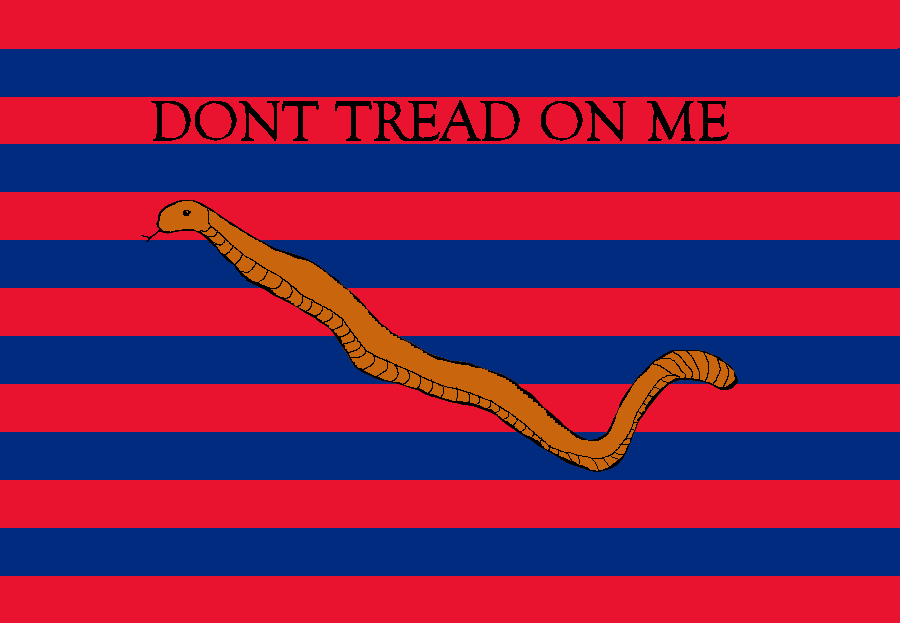
 George H. Preble published a book: History Of The Flag Of The United States Of America in 1872. In that book, Preble noted that: "the flag hoisted by Jones was composed of alternate stripes of red and blue with a rattlesnake running across the field, and the usual motto." In subsequent editions of the book, Preble removed the statement. But despite the removal of the statement from the text, a color plate showing various flags from the American Revolutionary War period continued to be included in later editions of the book. One of the flags depicted in that color plate was the red and blue striped flag with an outstretched rattlesnake.
George H. Preble published a book: History Of The Flag Of The United States Of America in 1872. In that book, Preble noted that: "the flag hoisted by Jones was composed of alternate stripes of red and blue with a rattlesnake running across the field, and the usual motto." In subsequent editions of the book, Preble removed the statement. But despite the removal of the statement from the text, a color plate showing various flags from the American Revolutionary War period continued to be included in later editions of the book. One of the flags depicted in that color plate was the red and blue striped flag with an outstretched rattlesnake.
 The connection between this variation of the First Navy Jack and the South Carolina Navy is questionable. It appears that the association was made in 1917 by a statement made by Byron McCandless in the National Geographic Magazine: "The Southern colonies seemed especially fond of the device. South Carolina adopted for her navy the red and blue stripes crossed by the gliding snake." There was no reference provided for the statement, but it apparently stuck in the minds of readers nationwide.
The connection between this variation of the First Navy Jack and the South Carolina Navy is questionable. It appears that the association was made in 1917 by a statement made by Byron McCandless in the National Geographic Magazine: "The Southern colonies seemed especially fond of the device. South Carolina adopted for her navy the red and blue stripes crossed by the gliding snake." There was no reference provided for the statement, but it apparently stuck in the minds of readers nationwide.
 The provincial legislature of South Carolina did not intend for the rattlesnake on red and blue striped flag to become the symbol of its navy. The flag described by Rawlin Lowndes, President of the South Carolina General Assembly, in a letter he sent to Commodore Alexander Gillon, Commander of the ship South Carolina, dated 19 July 1778 noted: "The Flagg which you are to wear and which is the flagg by which the Navy of this State is in the future to be distinguished, is a rich Blue field, a Rice Sheaf Worked with Gold (or Yellow) in the Center, and 13 Stars Silver (or White) Scattered over the field."
The provincial legislature of South Carolina did not intend for the rattlesnake on red and blue striped flag to become the symbol of its navy. The flag described by Rawlin Lowndes, President of the South Carolina General Assembly, in a letter he sent to Commodore Alexander Gillon, Commander of the ship South Carolina, dated 19 July 1778 noted: "The Flagg which you are to wear and which is the flagg by which the Navy of this State is in the future to be distinguished, is a rich Blue field, a Rice Sheaf Worked with Gold (or Yellow) in the Center, and 13 Stars Silver (or White) Scattered over the field."

